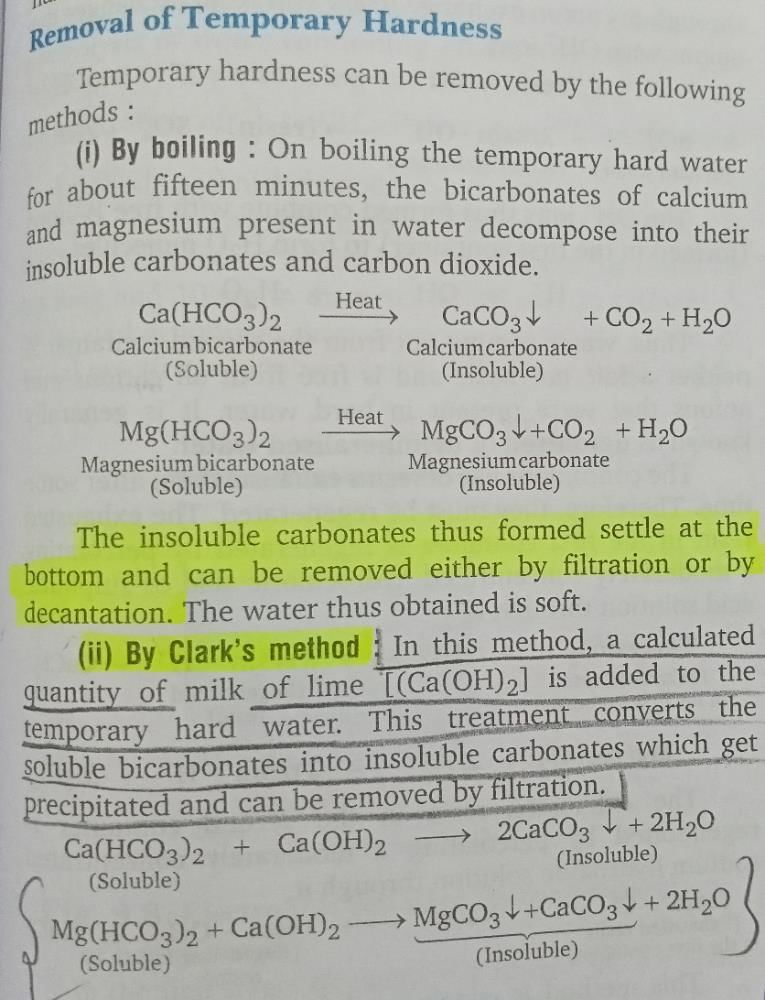Class 11 Exam > Class 11 Questions > Temporary hardness It can be removed in boili...
Start Learning for Free
Temporary hardness It can be removed in boiling by precipitating
- a)CaCO3.Mg(OH)2
- b)Mg(HCO3)2.CaCO3
- c)Mg(HCO3)2Ca(HCO3)2
- d)Ca(HCO3)2.Mg(OH)2
Correct answer is option 'A'. Can you explain this answer?
| FREE This question is part of | Download PDF Attempt this Test |
Verified Answer
Temporary hardness It can be removed in boiling by precipitatinga)CaCO...
CaCO3.Mg(OH)2 can be precipitate out in order to remove temporary hardness.
Most Upvoted Answer
Temporary hardness It can be removed in boiling by precipitatinga)CaCO...

Free Test
FREE
| Start Free Test |
Community Answer
Temporary hardness It can be removed in boiling by precipitatinga)CaCO...
Temporary Hardness Removal
Temporary hardness refers to the presence of dissolved calcium bicarbonate (Ca(HCO3)2) and magnesium bicarbonate (Mg(HCO3)2) in water, which can be removed by boiling. When water is heated, the bicarbonates decompose to form insoluble carbonates, which precipitate out.
Correct Answer Explanation
The correct answer is option 'A', CaCO3.Mg(OH)2, because when temporary hardness is removed by boiling, calcium carbonate (CaCO3) and magnesium hydroxide (Mg(OH)2) are formed as precipitates. These insoluble compounds can be easily separated from the water, thereby removing temporary hardness.
Incorrect Options Explanation
- Option 'B', Mg(HCO3)2.CaCO3, is incorrect because it does not represent the compounds formed during the removal of temporary hardness by boiling.
- Option 'C', Mg(HCO3)2Ca(HCO3)2, is incorrect as it does not correspond to the products of the decomposition of bicarbonates during boiling.
- Option 'D', Ca(HCO3)2.Mg(OH)2, is incorrect as it does not reflect the compounds that precipitate out during the removal of temporary hardness by boiling.
In conclusion, the correct compounds formed during the removal of temporary hardness by boiling are calcium carbonate (CaCO3) and magnesium hydroxide (Mg(OH)2), which is represented by option 'A'.
Temporary hardness refers to the presence of dissolved calcium bicarbonate (Ca(HCO3)2) and magnesium bicarbonate (Mg(HCO3)2) in water, which can be removed by boiling. When water is heated, the bicarbonates decompose to form insoluble carbonates, which precipitate out.
Correct Answer Explanation
The correct answer is option 'A', CaCO3.Mg(OH)2, because when temporary hardness is removed by boiling, calcium carbonate (CaCO3) and magnesium hydroxide (Mg(OH)2) are formed as precipitates. These insoluble compounds can be easily separated from the water, thereby removing temporary hardness.
Incorrect Options Explanation
- Option 'B', Mg(HCO3)2.CaCO3, is incorrect because it does not represent the compounds formed during the removal of temporary hardness by boiling.
- Option 'C', Mg(HCO3)2Ca(HCO3)2, is incorrect as it does not correspond to the products of the decomposition of bicarbonates during boiling.
- Option 'D', Ca(HCO3)2.Mg(OH)2, is incorrect as it does not reflect the compounds that precipitate out during the removal of temporary hardness by boiling.
In conclusion, the correct compounds formed during the removal of temporary hardness by boiling are calcium carbonate (CaCO3) and magnesium hydroxide (Mg(OH)2), which is represented by option 'A'.
Attention Class 11 Students!
To make sure you are not studying endlessly, EduRev has designed Class 11 study material, with Structured Courses, Videos, & Test Series. Plus get personalized analysis, doubt solving and improvement plans to achieve a great score in Class 11.

|
Explore Courses for Class 11 exam
|

|
Similar Class 11 Doubts
Temporary hardness It can be removed in boiling by precipitatinga)CaCO3.Mg(OH)2b)Mg(HCO3)2.CaCO3c)Mg(HCO3)2Ca(HCO3)2d)Ca(HCO3)2.Mg(OH)2Correct answer is option 'A'. Can you explain this answer?
Question Description
Temporary hardness It can be removed in boiling by precipitatinga)CaCO3.Mg(OH)2b)Mg(HCO3)2.CaCO3c)Mg(HCO3)2Ca(HCO3)2d)Ca(HCO3)2.Mg(OH)2Correct answer is option 'A'. Can you explain this answer? for Class 11 2024 is part of Class 11 preparation. The Question and answers have been prepared according to the Class 11 exam syllabus. Information about Temporary hardness It can be removed in boiling by precipitatinga)CaCO3.Mg(OH)2b)Mg(HCO3)2.CaCO3c)Mg(HCO3)2Ca(HCO3)2d)Ca(HCO3)2.Mg(OH)2Correct answer is option 'A'. Can you explain this answer? covers all topics & solutions for Class 11 2024 Exam. Find important definitions, questions, meanings, examples, exercises and tests below for Temporary hardness It can be removed in boiling by precipitatinga)CaCO3.Mg(OH)2b)Mg(HCO3)2.CaCO3c)Mg(HCO3)2Ca(HCO3)2d)Ca(HCO3)2.Mg(OH)2Correct answer is option 'A'. Can you explain this answer?.
Temporary hardness It can be removed in boiling by precipitatinga)CaCO3.Mg(OH)2b)Mg(HCO3)2.CaCO3c)Mg(HCO3)2Ca(HCO3)2d)Ca(HCO3)2.Mg(OH)2Correct answer is option 'A'. Can you explain this answer? for Class 11 2024 is part of Class 11 preparation. The Question and answers have been prepared according to the Class 11 exam syllabus. Information about Temporary hardness It can be removed in boiling by precipitatinga)CaCO3.Mg(OH)2b)Mg(HCO3)2.CaCO3c)Mg(HCO3)2Ca(HCO3)2d)Ca(HCO3)2.Mg(OH)2Correct answer is option 'A'. Can you explain this answer? covers all topics & solutions for Class 11 2024 Exam. Find important definitions, questions, meanings, examples, exercises and tests below for Temporary hardness It can be removed in boiling by precipitatinga)CaCO3.Mg(OH)2b)Mg(HCO3)2.CaCO3c)Mg(HCO3)2Ca(HCO3)2d)Ca(HCO3)2.Mg(OH)2Correct answer is option 'A'. Can you explain this answer?.
Solutions for Temporary hardness It can be removed in boiling by precipitatinga)CaCO3.Mg(OH)2b)Mg(HCO3)2.CaCO3c)Mg(HCO3)2Ca(HCO3)2d)Ca(HCO3)2.Mg(OH)2Correct answer is option 'A'. Can you explain this answer? in English & in Hindi are available as part of our courses for Class 11.
Download more important topics, notes, lectures and mock test series for Class 11 Exam by signing up for free.
Here you can find the meaning of Temporary hardness It can be removed in boiling by precipitatinga)CaCO3.Mg(OH)2b)Mg(HCO3)2.CaCO3c)Mg(HCO3)2Ca(HCO3)2d)Ca(HCO3)2.Mg(OH)2Correct answer is option 'A'. Can you explain this answer? defined & explained in the simplest way possible. Besides giving the explanation of
Temporary hardness It can be removed in boiling by precipitatinga)CaCO3.Mg(OH)2b)Mg(HCO3)2.CaCO3c)Mg(HCO3)2Ca(HCO3)2d)Ca(HCO3)2.Mg(OH)2Correct answer is option 'A'. Can you explain this answer?, a detailed solution for Temporary hardness It can be removed in boiling by precipitatinga)CaCO3.Mg(OH)2b)Mg(HCO3)2.CaCO3c)Mg(HCO3)2Ca(HCO3)2d)Ca(HCO3)2.Mg(OH)2Correct answer is option 'A'. Can you explain this answer? has been provided alongside types of Temporary hardness It can be removed in boiling by precipitatinga)CaCO3.Mg(OH)2b)Mg(HCO3)2.CaCO3c)Mg(HCO3)2Ca(HCO3)2d)Ca(HCO3)2.Mg(OH)2Correct answer is option 'A'. Can you explain this answer? theory, EduRev gives you an
ample number of questions to practice Temporary hardness It can be removed in boiling by precipitatinga)CaCO3.Mg(OH)2b)Mg(HCO3)2.CaCO3c)Mg(HCO3)2Ca(HCO3)2d)Ca(HCO3)2.Mg(OH)2Correct answer is option 'A'. Can you explain this answer? tests, examples and also practice Class 11 tests.

|
Explore Courses for Class 11 exam
|

|
Suggested Free Tests
Signup for Free!
Signup to see your scores go up within 7 days! Learn & Practice with 1000+ FREE Notes, Videos & Tests.
























